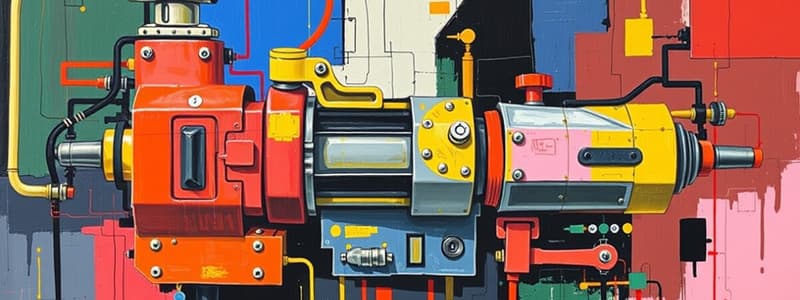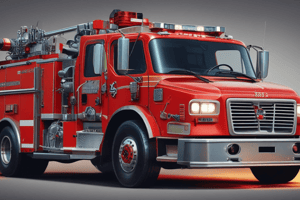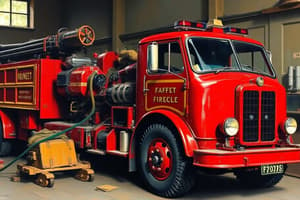Podcast
Questions and Answers
Which of the following apparatus malfunctions does NOT require the unit to be placed Out of Service?
Which of the following apparatus malfunctions does NOT require the unit to be placed Out of Service?
- Severe air leak
- Brake lights operational (correct)
- Coolant leak (until leak is checked)
- Belts beginning to squeal
What action must be taken immediately upon identifying an apparatus malfunction?
What action must be taken immediately upon identifying an apparatus malfunction?
- Notify the on-duty Battalion Chief (correct)
- Submit a report to the Fire Chief
- Call for backup
- Post on social media
Which malfunction is associated with steering issues?
Which malfunction is associated with steering issues?
- Steering suddenly feeling 'loose' (correct)
- Emergency lights inoperative
- Damaged tires
- Aerial device failure
Who must be notified after placing the affected apparatus Out of Service?
Who must be notified after placing the affected apparatus Out of Service?
Which item, if found to be malfunctioning, directly affects the apparatus's ability to operate safely?
Which item, if found to be malfunctioning, directly affects the apparatus's ability to operate safely?
What should happen after submitting a maintenance ticket in Checkit?
What should happen after submitting a maintenance ticket in Checkit?
Study Notes
Apparatus Malfunctions Leading to Out of Service Status
- Water pump failure requires immediate action to ensure operational integrity.
- Aerial device failure compromises safety and functionality of the apparatus.
- Malfunctioning brakes pose a critical risk, necessitating the unit to be placed out of service.
- Severe air leaks indicate potential system failures, warranting immediate suspension of use.
- Inoperative headlights, brake lights, or tail lights impair visibility and safety on the road.
- Emergency lights must be functional; any failure demands the unit be taken out of service.
- Coolant leaks must be verified before the unit can be utilized again to prevent overheating.
- Substantial oil leaks from engine, transmission, rear end, power steering, or hydraulic systems need checking before return to service.
- Damaged tires can compromise traction and handling, requiring removal from service.
- Belts that squeal may indicate wear or malfunction, needing assessment before operation.
- A sudden "loose" steering feel suggests potential steering system failure; the unit must be suspended from use.
- Any additional safety concerns identified by crews prompt immediate action to take the apparatus out of service.
Notification Protocols
- Upon identifying these malfunctions, the affected unit must be declared Out of Service immediately.
- Verbal notification to an on-duty Battalion Chief is required to initiate proper channels for repair.
- Maintenance tickets must be submitted through the Checkit system for documentation and follow-up.
- The Battalion Chief is responsible for informing the Assistant Chief of Operations or Assistant Chief of Support Services about the situation.
Studying That Suits You
Use AI to generate personalized quizzes and flashcards to suit your learning preferences.
Description
This quiz covers critical apparatus malfunctions that lead to an out of service status, focusing on water pump failures, brake issues, and safety lighting. It aims to ensure participants understand the necessary actions to maintain operational integrity and safety. Participants will learn about various mechanical failures and the protocols to handle them effectively.




